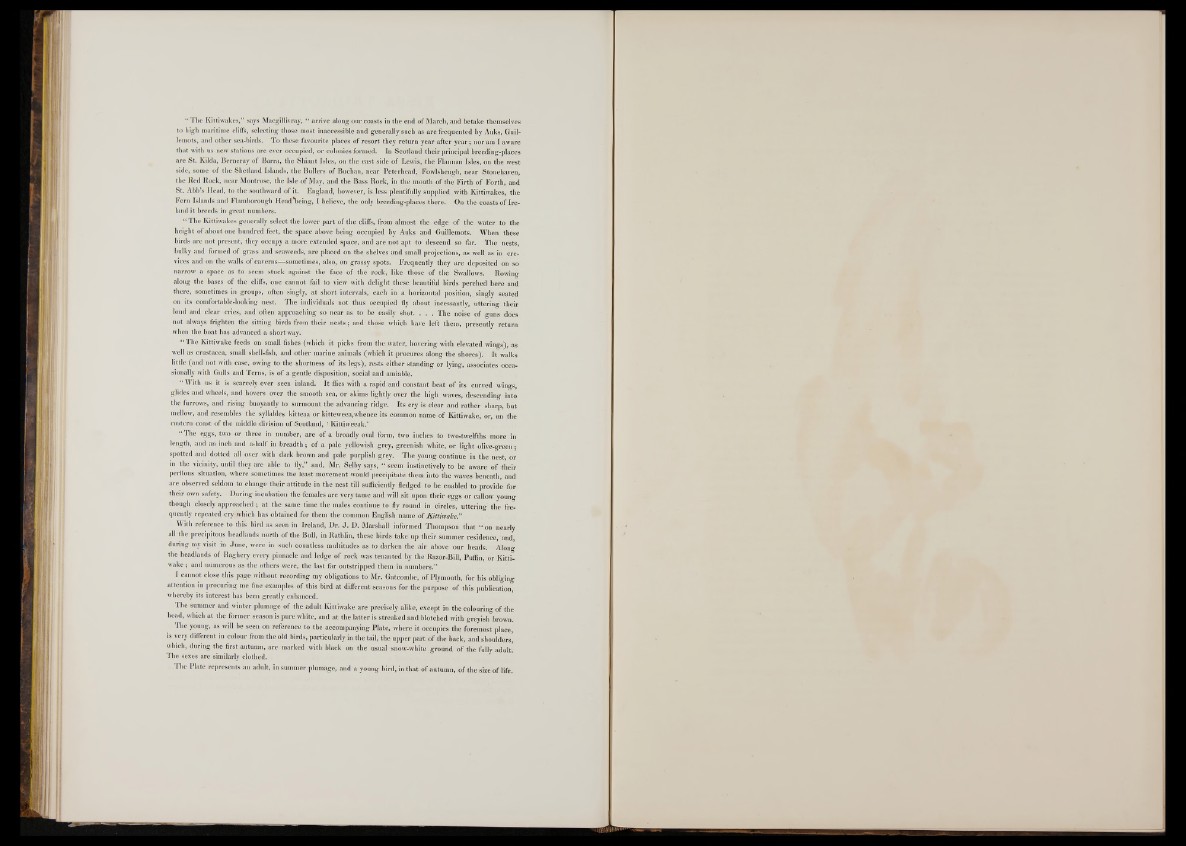
“ The Kiltiwakes,” says Macgillivray, “ arrive along our coasts in the end of March, and betake themselves
to high maritime cliffs, selecting those most inaccessible and generally such as are frequented by Auks, Guillemots,
and other sea-birds. To these favourite places of resort they return year after year; noram I aware
that with us new stations are ever occupied, or colonies formed. In Scotland their principal breeding-places
are St. Kilda, Berneray of Barra, the Shiant Isles, on the east side o f Lewis, the Flannari Isles, on the west
side, some of the Shetland Islands, the Bullers of Buchan, near Peterhead, Fowlsheugh, near Stonehaven,
the Red Rock, near Montrose, the Isle o f May, and the Bass Rock, in the mouth o f the Firth o f Forth, and
St. Abb’s Head, to the southward o f it. England, however, is less plentifully supplied with Kittiwakes, the
Fern Islands and Flamborough Hcad'being, I believe, the only breeding-places there. On the coasts of Ireland
it breeds in great numbers.
“ The Kittiwakes generally select the lower part of the cliffs, from almost the edge of the water to the
height of about one hundred feet, the space above being occupied by Auks and Guillemots. When these
birds are not present, they occupy a more extended space, and are not apt to descend so far. The nests,
bulky and formed of grass and seaweeds, are placed on the shelves and small projections, as well as in crevices
and on the walls o f caverns— sometimes, also, on grassy spots. Frequently they are deposited on so
narrow a space as to seem stuck against the face o f the rock, like those o f the Swallows. Rowing
aloug the bases o f the cliffs, one cannot fail to view with delight these beautiful birds perched here and
there, sometimes in groups, often singly, at short intervals, each in a horizontal position,, singly seated
on its comfortable-looking nest. The individuals not thus occupied fly about incessantly, uttering their
loud and clear cries, and often approaching so near as to be easily shot. . . . The noise o f guns does
not always frighten the sitting birds from their nests; and those which have left them, presently return
when the boat has advanced a short way.
“ The Kittiwake feeds on small fishes (which it picks from the water, hovering with elevated wings), as
well as Crustacea, small shell-fish, and other marine animals (which it procures along the shores). It walks
little (and not with ease, owing to the shortness of its legs), rests either standing or lying, associates occasionally
with Gulls and Terns, is of a gentle disposition, social and amiable.
“ With us it is scarcely ever seen inland. It flies with a rapid and constant beat o f its curved wings,
glides and wheels, and hovers over the smooth sea, or skims lightly over the high waves, descending into
the furrows, and rising buoyantly to surmount the advancing ridge. Its cry is clear and rather sharp, but
mellow, and resembles the syllables kitteaa or kitteweea,whence its common name o f Kittiwake, or, on the
eastern coast of the middle division o f Scotland, ‘ Kittiweeak.'
“ The eggs, two or three in number, are of a broadly oval form, two inches to two-twelfths more in
length, and an inch and a-half in breadth; o f a pale yellowish grey, greenish white, or light olive-green;
spotted and dotted all over with dark brown and pale purplish grey. The young continue in the nest, or
in the vicinity, until they are able to fly,” and, Mr. Selby says, “ seem instinctively to be aware o f their
perilous situation, where sometimes the least movement would precipitate them into the waves beneath, and
are observed seldom to change their attitude in the nest till sufficiently fledged to be enabled to provide for
their own safety. During incubation the females are very tame and will sit upon their eggs or callow youn«-
though closely approached ; at the same time the males continue to fly round in circles, uttering the frequently
repeated cry which has obtained for them the common English name o f JKittiivakeMitivi
With reference to this bird as seen in Ireland, Dr. J. D. Marshall informed Thompson that “ on nearly
all the precipitous headlands north o f the Bull, in Rathlin, these birds take up their summer residence, and,
during my visit in June, were in such countless multitudes as to darken the air above our heads. Along
the headlands of Raghery every pinnacle and ledge o f rock was tenanted by the Razor-Bill, Puffin, or Kittiwake
; and numerous as the others were, the last far outstripped them in numbers.”
I cannot close this page without recording my obligations to Mr. Gatcombe, of Plymouth, for his obliging
attention in procuring me fine examples o f this bird at different seasons for the purpose of this publication,
whereby its interest has been greatly enhauced.
The summer and winter plumage o f the adult Kittiwake are precisely alike, except in the colouring of the
head, which at the former season is pure white, and at the latter is streaked and blotched with greyish brown.
The young, as will be seen on reference to the accompanying Plate, where it occupies the foremost place,
is very different in colour from the old birds, particularly in the tail, the upper part o f the back, and shoulders,
which, during the first autumn, are marked with black on the usual snow-white ground o f the fully adult.
The sexes are similarly clothed.
The Plate represents an adult, in summer plumage, and a young bird, in that of autumn, o f the size o f life.